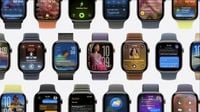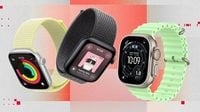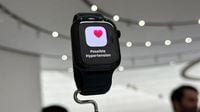Apple’s latest smartwatch, the Apple Watch Series 11, made its official debut on September 9, 2025, at the company’s highly anticipated “Awe Dropping” event in Cupertino. The unveiling was accompanied by the introduction of the Apple Watch SE 3 and a new Apple Watch Ultra, rounding out a trio of fresh wearables for the year. For Apple fans and tech enthusiasts alike, the Series 11’s launch marks a notable—if not revolutionary—step forward in wearable technology, with a focus on health, durability, and convenience.
At first glance, the Series 11 appears to be a modest update over last year’s Series 10, but a closer look reveals several meaningful improvements. According to Apple, the Series 11 is now the “thinnest and most comfortable design” in the Apple Watch lineup, measuring just 9.7 millimeters in thickness. It’s available in two case sizes—42mm and 46mm—offering a larger, more immersive display. The new LTPO3 wide-angle OLED screen can hit a dazzling 2,000 nits outdoors, making it twice as bright as the previous generation and easier to read in direct sunlight. The Ion-X glass covering the display, now enhanced with a proprietary ceramic coating, is twice as scratch-resistant as before, while the titanium models boast a sapphire front crystal for even greater durability.
Color options have expanded, too. The aluminum Series 11 comes in jet black, rose gold, silver, and a brand-new space gray, while polished titanium models arrive in natural, gold, and slate. These choices, combined with a refreshed lineup of bands—including new Nike Sport Loop colors with reflective yarn—ensure there’s a style to suit every wrist.
One of the most significant upgrades is battery life. As reported by Mashable, the Series 11 now delivers up to 24 hours of battery life on a single charge—a substantial jump from the 18-hour standard that Apple maintained for years. For those who need even more longevity, low-power mode extends usage up to 38 hours. Fast charging is also improved: just 15 minutes on the charger provides up to eight hours of battery life, while a half-hour brings the watch to 80% capacity. This makes overnight charging less of a necessity and opens the door for continuous health and sleep tracking.
Health features remain front and center in Apple’s pitch for the Series 11. The device introduces groundbreaking hypertension notifications, which use the optical heart sensor to passively analyze blood vessel response over 30-day periods. If signs of chronic high blood pressure are detected, the watch notifies the user—potentially alerting millions of people to a condition that often goes undiagnosed. “Hypertension is the leading preventable cause of heart attack and stroke, yet millions remain undiagnosed,” said Dr. Harlan Krumholz, a cardiologist at Yale University, in Apple’s press release. “Making accurate detection easy and part of daily life can help people get care earlier and prevent avoidable harm.”
This feature, pending FDA clearance in the U.S., is expected to be available in over 150 countries and regions—including the EU—later this month. Apple says the detection algorithm was trained on data from over 100,000 participants and validated in a clinical study of more than 2,000 people. If a user receives a hypertension alert, Apple recommends logging blood pressure with a third-party cuff for seven days and sharing the results with a healthcare provider, aligning with American Heart Association guidelines.
Sleep tracking also gets a boost with the introduction of the new sleep score feature, which analyzes sleep duration, time spent in each stage, and bedtime consistency to provide an overall quality rating. The scoring system, informed by guidance from the American Academy of Sleep Medicine and developed using over five million nights of sleep data, is designed to help users understand and improve their rest. The sleep score is displayed in the Sleep app, with a breakdown of the most critical components and the ability to track progress over time in the Health app on iPhone.
Beyond health, Series 11 packs a suite of sensors and performance upgrades. It features both an electric and third-generation optical heart rate sensor, a water temperature sensor, depth gauge, ECG and Blood Oxygen monitoring, and the new S11 chip. The S11 is a refined version of Apple’s previous smartwatch processors, ensuring snappy performance and efficient power management. Both Series 11 and SE 3 include the W3 wireless chip, a 4-core Neural Engine, 64GB of storage, and 5G cellular support for faster data and more reliable connectivity. The redesigned cellular antenna covers more bands and can engage two system antennas at once to boost signal strength in weak coverage areas.
On the software side, watchOS 26 brings a host of new features: Workout Buddy, powered by Apple Intelligence, offers real-time, personalized spoken motivation during workouts; a redesigned watch face gallery introduces Flow and Exactograph faces; and the interface gets a fresh look with Liquid Glass effects. Smart Stack hints provide proactive, context-aware suggestions, while Live Translation in Messages and the Notes app make the watch even more versatile. Gesture controls have also expanded, with a new wrist flick gesture joining the double-tap for hands-free interaction.
For those who value sustainability, Apple touts that the Series 11 is made with 40% recycled content, including 100% recycled cobalt in the battery and recycled aluminum or titanium in the case. Manufacturing is powered by renewable electricity, and packaging is entirely fiber-based and recyclable. According to Apple, these efforts have helped reduce the company’s global greenhouse gas emissions by more than 60% since 2015.
Of course, the Series 11 isn’t the only new Apple Watch on offer. The Apple Watch SE 3, updated after a three-year hiatus, now features an always-on display and shares the same S10 processor as last year’s flagship, making it a compelling option for budget-conscious buyers. Priced at $249 for the 40mm model and $279 for the 44mm, the SE 3 offers many core features of its pricier sibling but skips out on some advanced health sensors, the new design, and the longer battery life. Meanwhile, the Series 11 starts at $399 for the 42mm and $429 for the 46mm, positioning it as the premium choice for those who want the latest technology on their wrist.
Pre-orders for the Series 11 began on September 9, with in-store availability set for September 19 across the U.S., U.K., Canada, Australia, and more than 50 other countries. New buyers may also be eligible for three months of Apple Fitness+ and Apple Music, adding extra value to the purchase.
While the Series 11 may not be the radical leap some had hoped for—major changes are rumored for the Series 12 in 2026—it’s a well-rounded, durable, and feature-rich smartwatch that cements Apple’s lead in the wearables space. For those seeking advanced health tracking, better battery life, and a stylish, scratch-resistant design, the Apple Watch Series 11 is a compelling choice this fall.


